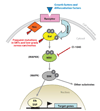Ovarian cancer
- PMID: 18842102
- PMCID: PMC2679364
- DOI: 10.1146/annurev.pathol.4.110807.092246
Ovarian cancer
Abstract
Ovarian carcinomas are a heterogeneous group of neoplasms and are traditionally subclassified based on type and degree of differentiation. Although current clinical management of ovarian carcinoma largely fails to take this heterogeneity into account, it is becoming evident that each major histological type has characteristic genetic defects that deregulate specific signaling pathways in the tumor cells. Moreover, within the most common histological types, the molecular pathogenesis of low-grade versus high-grade tumors appears to be largely distinct. Mouse models of ovarian carcinoma have been developed that recapitulate many of the morphological features, biological behavior, and gene-expression patterns of selected subtypes of ovarian cancer. Such models will likely prove useful for studying ovarian cancer biology and for preclinical testing of molecularly targeted therapeutics, which may ultimately lead to better clinical outcomes for women with ovarian cancer.
Figures






References
-
- Jemal A, Siegel R, Ward E, Murray T, Xu J, Thun MJ. Cancer statistics, 2007. CA Cancer J Clin. 2007;57:43–66. - PubMed
-
- Feeley KM, Wells M. Precursor lesions of ovarian epithelial malignancy. Histopathology. 2001;38:87–95. - PubMed
-
- Bell DA. Origins and molecular pathology of ovarian cancer. Mod Pathol. 2005;18 Suppl 2:S19–S32. - PubMed
-
- Dubeau L. The cell of origin of ovarian epithelial tumors and the ovarian surface epithelium dogma: does the emperor have no clothes? Gynecol Oncol. 1999;72:437–442. - PubMed
-
- Kurman RJ. Blaustein's pathology of the female genital tract. 5th ed. New York: Springer-Verlag; 2002.
Publication types
MeSH terms
Grants and funding
LinkOut - more resources
Full Text Sources
Other Literature Sources
Medical

